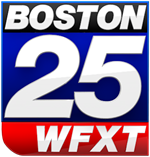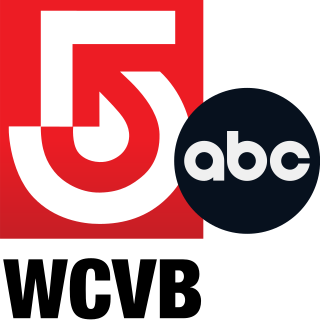Related Research Articles

WBZ is a commercial AM radio station, licensed to Boston, Massachusetts, and owned and operated by iHeartMedia, Inc. Its studios and offices are located on Cabot Road in the Boston suburb of Medford.
WBZ-TV is a television station in Boston, Massachusetts, United States, serving as the market's CBS outlet. It is owned and operated by the network's CBS News and Stations division alongside independent WSBK-TV. Both stations share studios on Soldiers Field Road in the Allston–Brighton section of Boston. WBZ-TV's transmitter is located on Cedar Street in Needham, Massachusetts, on a tower site that was formerly owned by CBS and is now owned by American Tower Corporation.

WFXT is a television station in Boston, Massachusetts, United States, affiliated with the Fox network and owned by Cox Media Group. Its studios are located on Fox Drive in Dedham, and its transmitter is located on Cabot Street in Needham. WFXT is the largest Fox affiliate by market size that is not owned and operated by the network, although it was previously owned by Fox on two occasions.

WEEI is a commercial sports gambling AM radio station licensed to Boston, Massachusetts, serving Greater Boston and much of New England. Owned by Audacy, Inc., WEEI is the Boston affiliate for the Audacy-owned BetQL Network and CBS Sports Radio, serving as a gambling-focused brand extension of its main sports radio station in the market, WEEI-FM. The WEEI studios are located in Boston's Brighton neighborhood, while the station transmitter resides in the Boston suburb of Needham. In addition to a standard analog transmission, WEEI is available online via Audacy.

WGBX-TV, branded on-air as GBH 44, is the secondary PBS member television station in Boston, Massachusetts, United States. It is owned by the WGBH Educational Foundation, alongside WGBH-TV, WFXZ-CD, and multiple public radio stations in Boston and on Cape Cod. WGBX-TV, WGBH-TV and the WGBH and WCRB radio stations share studios on Guest Street in northwest Boston's Brighton neighborhood; WGBX-TV's transmitter is located on Cedar Street in Needham, Massachusetts.

WCVB-TV is a television station in Boston, Massachusetts, United States, affiliated with ABC and owned by Hearst Television. The station's studios are located on TV Place in Needham, Massachusetts, and its transmitter is located on Cedar Street, also in Needham, on a tower shared with several other television and radio stations.

WSBK-TV is an independent television station in Boston, Massachusetts, United States. It is owned by the CBS News and Stations group alongside CBS outlet WBZ-TV. The two stations share studios on Soldiers Field Road in the Allston–Brighton section of Boston. WSBK-TV's transmitter is located on Cedar Street in Needham, Massachusetts, on a tower site that was formerly owned by CBS and is now owned by American Tower Corporation.
WLVI is a television station licensed to Cambridge, Massachusetts, United States, serving the Boston area as an affiliate of The CW. It is owned by Sunbeam Television alongside WHDH, an independent station. WLVI and WHDH share studios at Bulfinch Place in downtown Boston; through a channel sharing agreement, the two stations transmit using WHDH's spectrum from the WHDH-TV tower in Newton, Massachusetts.

WWBX is a radio station with a hot adult contemporary format in Boston, Massachusetts. The format started at 98.5 FM on February 9, 1991, and moved to 104.1 FM, replacing WBCN on August 12, 2009, to allow for the launch of WBZ-FM at 98.5 the next day. Its studios are located in Brighton, and its transmitter is on the upper FM mast of the Prudential Tower.
The Big Show is a former sports talk radio program hosted by Glenn Ordway on Boston's WEEI-FM 93.7 FM. Started in August 1995, the show was hosted by Ordway and former Boston Globe columnist Michael Holley. The show ended on March 19, 2013.

WROL is a radio station in Boston, Massachusetts. The station is owned by Salem Media Group. Most of WROL's programming is religious including local ministers as well as national radio hosts such as Dr. Charles Stanley, Jay Sekulow and Eric Metaxas. Former WBZ-TV news anchor-turned-minister Liz Walker also has a program on the station. WROL also airs several Irish music blocks on weekends, including the Irish Hit Parade on Saturdays and A Feast of Irish Music on Sundays.
Frederick Michael Cusick was an American ice hockey broadcaster who served as the Boston Bruins play-by-play announcer from 1971 until 1997 on WSBK-TV in Boston, and from 1984 until 1995 on NESN. Counting his radio broadcasts, he was a Bruins' announcer for an unprecedented 45 years, and was an active sports announcer for over seven decades. He is best known for yelling "SCORE!" when a Boston player scored a goal.
The Yankee Network was an American radio network, based in Boston, Massachusetts, with affiliate radio stations throughout New England. At the height of its influence, the Yankee Network had as many as twenty-four affiliated radio stations. The network was co-founded by John Shepard III and his brother Robert, in 1929–1930. The beginnings of what became the Yankee Network occurred in the mid-1920s, when John Shepard's Boston station WNAC linked by telephone land lines with Robert Shepard's station in Providence, Rhode Island, WEAN, so that the two stations could share or exchange programming. Those two stations became the first two Yankee Network stations. In 1930, they were joined by the first affiliated radio stations, including WLBZ in Bangor, Maine; WORC in Worcester, Massachusetts; WNBH in New Bedford, Massachusetts; and WICC in Bridgeport, Connecticut. During the 1930s, the network became known for developing its own local and regional news bureau, the Yankee News Service. The Yankee Network and the Yankee News Service operated until February 1967.
Donald Edward Kent was an American radio and television weather forecaster for several decades in the Boston, Massachusetts area. He was known as "Boston's first TV Weatherman."

Clair Robert "Bob" Emery, known professionally as Big Brother Bob Emery, was a radio and television pioneer and children's show host. He is best known for his pioneer late-1940s network television show, Small Fry Club, and for his long career as a local broadcaster in Boston before and after that.
Robert Henry Castellon, known as Bob Wilson, was an American radio personality and hockey broadcaster who served as the longtime play-by-play announcer of the Boston Bruins of the National Hockey League. In 1987, Wilson was honoured with the Foster Hewitt Memorial Award, enshrining him in the broadcasters' wing of the Hockey Hall of Fame. He was inducted into the Massachusetts Broadcaster's Hall of Fame in 2007. Wilson's booming baritone voice and his ability to articulate for radio listeners the dynamic flow and possession changes of ice hockey distinguished him from his peers. He also was noted for his detailed descriptions of hockey fights, which pleased his fans but sometimes gained him disapproval from critics.
Robert E. Neumeier was an American sportscaster for several Boston-area media outlets. He also appeared on NBC Sports, specializing in Thoroughbred racing.

WHDH-TV was a television station in Boston, Massachusetts, United States. The station ceased operations on March 18, 1972, following the revocation of the station's license. The channel 5 allocation in the market was taken over by WCVB-TV the following morning, March 19, 1972. WCVB operates using a separate license from WHDH-TV; conversely, the original WHDH-TV is also of no relation to the current WHDH, which is a news-intensive independent; it served as the Boston market's NBC affiliate from January 2, 1995, through December 31, 2016.

WBZ-FM is a commercial sports radio station licensed to Boston, Massachusetts, serving Greater Boston and much of surrounding New England. Owned by the Beasley Broadcast Group, WBZ-FM is the Boston affiliate for Fox Sports Radio; the flagship station for the New England Patriots, Boston Bruins, Boston Celtics, and New England Revolution radio networks; and the radio home of Fred Toettcher, Scott Zolak, Mike Felger, Tony Massarotti, and Bob Socci. The WBZ-FM studios are located in Waltham, while the station transmitter resides in the Boston suburb of Newton. In addition to a standard analog transmission, WBZ-FM broadcasts over two HD Radio channels, and is available online.

WNAC-TV, channel 7, was a television station located in Boston, Massachusetts, United States. The station was owned by RKO General. Originally established in 1948, WNAC-TV signed off for the final time at 1:00 a.m. on May 22, 1982, due to improprieties by its parent company; it was replaced that morning with WNEV-TV, which operates on a separate license. The station was Boston's original CBS television affiliate; except for a period from 1961 to 1972 during which it was an ABC affiliate, WNAC-TV would remain with CBS until its replacement with WNEV-TV.
References
- ↑ William Buchanan. "Circus Highlights Delight Children." Boston Herald, April 4, 1956, p. 39.
- ↑ "Commerce High Plans 20th Reunion." Boston Herald, April 6, 1941, p. 39.
- 1 2 "Advertisement for Hum and Strum's New Recordings." Lowell Sun, May 21, 1948, p. 13.
- 1 2 "Hum, Strum on Channel 10." Boston Sunday Advertiser, December 13, 1953, p. 28.
- ↑ Anthony LaCamera. "Television Topics." Boston Sunday Advertiser, November 16, 1952, p. 41.
- 1 2 "Ask the Globe." Boston Globe, June 18, 1967, p. 31.
- 1 2 Alan Frazer. "My Boston." Boston Evening American, September 24, 1958, p. 14.
- 1 2 3 4 "Max Zides, 'Hum' of Singing Duo." Boston Herald-American, February 7, 1975, p. 10.
- ↑ Anthony LaCamera. "TV Tribute to Hum and Strum." Boston Evening American, April 4, 1956, p. 21.
- ↑ "What's On the Air." Boston Globe, December 22, 1928, p. 15.
- 1 2 3 4 "Rites Tomorrow for Thomas C. Currier, Member of Successful Vaudeville Duo." Boston Herald, July 10, 1986, p. 59.
- ↑ "Keith-Albee Theatre." Boston Herald, April 28, 1929, p. 3.
- ↑ "Hum and Strum Settle into 2-a-Week TV Groove." Boston Globe, September 25, 1949, p. B12.
- ↑ "Wrigley Group Offers Variety Music Program." (Rockford IL) Daily Register, April 6, 1928, p. 12.
- ↑ "Oxiton Clowns to Be Heard on Three Local Stations." Boston Herald, March 10, 1929, p. 33.
- ↑ "They Hum and Strum Tunes." Cleveland Plain Dealer, June 24, 1934, p. 20.
- ↑ "Jack Pepper Coming to the Met. Friday." Boston Herald, July 31, 1935, p. 19.
- ↑ "Ad for the Arcade, Springfield MA." Springfield Republican, October 1, 1933, p. 31.
- ↑ Sid Paine. "Boston." Billboard, July 16, 1938, p. 8.
- ↑ "Hum and Strum Head for Overseas." Boston Globe, June 4, 1944, p. C8.
- ↑ William Buchanan. "Hum, Strum Back in New England." Boston Herald, December 6, 1953, p. 14.
- ↑ "Max Zides, 70, Was 'Hum' in Duo." Boston Globe, February 7, 1975, p. 39.
- ↑ Alan Frazer. "News from Home Surprises Singer Cindy Parker in Naples." Boston Sunday Advertiser, February 6, 1955, p. 6.
- ↑ "Traveler Tele-Views." Boston Traveler, February 12, 1957, p. 58.
- ↑ David Pollack. Bob and Ray: Keener than Most Persons. Applause Books, 2013, chapter 3.
- ↑ David Goldin. Index to all Bob and Ray programs, August 24, 1948 to June 22, 1956.
- ↑ "Television Programs." Boston Herald, September 13, 1949, p. 18
- ↑ "Station People." Broadcasting, September 12, 1955, p. 102.
- ↑ Michael Jensen. "Why Not Order an Amphicar Now." Boston Herald, October 20, 1963, p. B7.